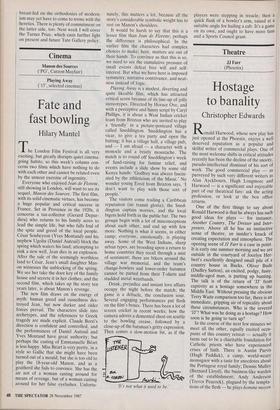Cinema
Manon des Sources ('PU, Curzon Mayfair)
Playing Away (`15', selected cinemas)
Fate and fast bowling
Hilary Mantel
The London Film Festival is all very exciting, but greatly disrupts quiet cinema- going habits; so this week's column con- cerns two films which have nothing to do with each other and cannot be related even by the utmost exercise of ingenuity.
Everyone who enjoyed Jean de Florette, still showing in London, will want to see its sequel, Manon des Sources. The first film, with its solid cinematic virtues, has become a huge popular and critical success in France. Set in Provence in the 1920s, it concerns a tax-collector (Gerard Depar- dieu) who returns to his family acres to lead the simple life, but who falls foul of the spite and greed of the local people. Cesar Soubeyron (Yves Montand) and his nephew Ugolin (Daniel Auteuil) block the spring which waters his land; attempting to sink a new well, Jean dies in an explosion. After the sale of the seemingly worthless land to Cesar, Jean's small daughter Man- on witnesses the unblocking of the spring. We see her take the door key of the family house and secrete it in her clothes; and the second film, which takes up the story ten years later, is about Manon's revenge.
The new film draws on the energy of myth: human greed and cussedness des- troyed Jean, but now darker and older forces prevail. The characters slide into archetypes, and the references to Greek tragedy are made explicit. Claude Bern's direction is confident and controlled, and the performances of Daniel Auteuil and Yves Montand have great authority; but perhaps the casting of Emmanuelle Bean is less happy. Miss Beart is very pretty, in a style so Gallic that she might have been turned out of a mould; but she is too old to play the 18-year-old Manon, and as a goatherd she fails to convince. She has the air not of a woman casting around for means of revenge, but of a woman casting around for her false eyelashes. Unfortu- nately, this matters a lot, because all the story's considerable symbolic weight has to rest on Manon's shoulders.
It would be harsh to say that this is a lesser film than Jean de Florette; perhaps the difference is philosophical. In the earlier film the characters had complex choices to make; here, matters are out of their hands. To convince us that this is so, we need to see the cumulative pressure of small events defeat free will and self- interest. But what we have here is imposed symmetry, narrative contrivance, and neat- ness instead of logic.
Playing Away is a modest, diverting and quite likeable film, which has attracted critical scorn because of its line-up of jolly stereotypes. Directed by Horace Ove, and with a perceptive and funny script by Caryl Phillips, it is about a West Indian cricket team from Brixton who are invited to play a 'friendly' in a picture-postcard village called Sneddington. Sneddington has a vicar, to give a tea party and open the batting; it has a village hall, a village pub, and — I am afraid — a character with a monocle and a bristly moustache. The match is to round off Sneddington's week of fund-raising for famine relief, and events include a slide show by some old Kenya hands: 'Godfrey was always fascin- ated by the athleticism of the Masai.' No wonder young Errol from Brixton says, 'I don't want to play with those sort of people.'
The visitors come trailing a Caribbean reputation (sic transit gloria); the Sned- dington captain worries, and the local bigots hold forth in the public bar. The two groups begin with a lot of misconceptions about each other, and end up with few more. Nothing is what it seems, in either camp; everyone, emotionally, is playing away. Some of the West Indians, sharp urban types, are brooding upon a return to home countries they recall through a mist of sentiment; there are bikers around the village war memorial, and the team's change-bowlers and lower-order batsmen cannot be parted from their T-shirts and studded metal wristbands.
Drink, prejudice and instant love affairs occupy the night before the match; the game is a debacle, the conclusion sour. Several engaging performances put flesh on the film's bones. There has been a lot of screen cricket in recent weeks; how the camera adores a demented chest-on scuttle to the bowling crease, followed by a close-up of the batsman's gritty expression. Then comes a slow-motion bit, as if the 'It's not what it used to be.' players were stepping in treacle; then a quick flash of a bowler's arm, raised at a suitable angle for hailing a cab. It's a game on its own, and ought to have more fans and a Sports Council grant.


































































 Previous page
Previous page